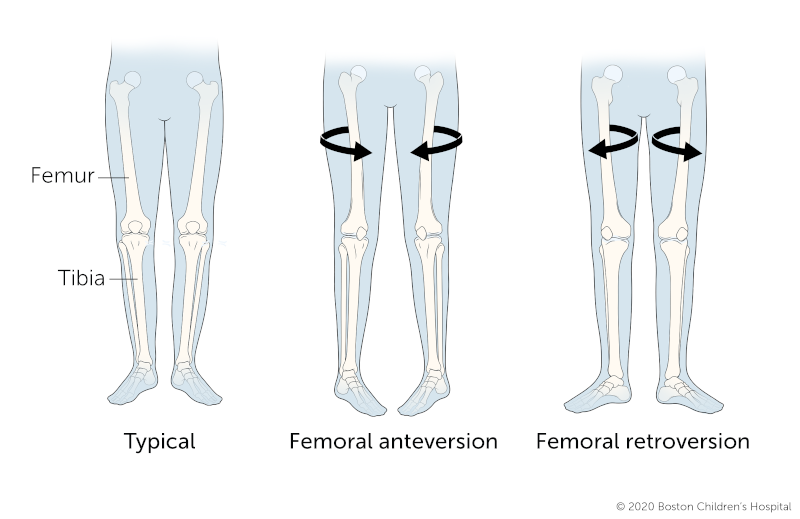Breadcrumb
- Home
- Conditions & Treatments
- Femoral Anteversion
What is femoral anteversion?
Femoral anteversion is an inward twisting of the thigh bone (femur). Femoral anteversion causes a child's knees and feet to turn inward and have a "pigeon-toed" appearance. This is also called in-toeing.
Femoral anteversion occurs in up to 10 percent of children. The condition is somewhat more common in girls than boys. It often, but not always, affects both legs.
Most children don't need treatment for femoral anteversion — the condition usually resolves on its own. For kids who need surgery for a severe form of the condition, the outlook is excellent. The surgeries are quite safe.
Femoral anteversion typically does not lead to arthritis or any other future health problems.

How serious is femoral anteversion?
For the vast majority of children, femoral anteversion is a minor condition that self-corrects by adolescence. Very few cases are painful or severe enough to require surgery.
Symptoms & Causes
What are the symptoms of femoral anteversion?
In toddlers and young children with developing hips, walking with pigeon-toes is normal. Even when caused by femoral anteversion, inward-pointing toes usually straighten out on their own as children learn to walk.
Signs of femoral anteversion usually first become noticeable when a child is between 2 to 4 years old, a time when inward rotation from the hip tends to increase. The condition becomes most obvious when a child is 5 to 6 years old.
If your child has any of the following symptoms of femoral anteversion, it’s a good idea to talk with their doctor:
- Pigeon-toed walking
- Inability to walk with their feet close together and legs straight
- Running with their legs swinging out
- Tripping and falling often
What causes femoral anteversion?
Femoral anteversion is usually considered to be a variation of normal development. Doctors don’t know what causes it or why some children develop severe femoral anteversion.
Diagnosis & Treatments
How is femoral anteversion diagnosed?
Your child’s doctor will conduct a physical exam to diagnose femoral anteversion. As part of the exam, the doctor will take your child’s complete prenatal, birth, and family medical history.
The physical exam also includes measurements to determine the degree of your child’s in-toeing. These measurements can be obtained easily just by placing ink or chalk on the bottom of your child's feet and having them walk on paper to leave an impression.
The doctor may use diagnostic tests to get detailed images of your child’s thigh bone and hip joint, including:
- Computed tomography (CT or CAT) scan uses X-ray equipment and powerful computers to create detailed, cross-sectional images of your child's body. A CT scan is the main imaging test used to confirm a diagnosis of femoral anteversion. It is faster than an MRI and more detailed than X-rays.
- MRI (magnetic resonance imaging) uses magnets, radio frequencies, and a computer to produce detailed images of organs and structures within your child’s body.
- X-rays use invisible electromagnetic energy beams to produce images of internal tissues, bones, and organs.
How is femoral anteversion treated?
Doctors treat most children who have femoral anteversion with close observation over the course of several years. For most children, the twisting of the thigh bone usually corrects by itself with time. Most children achieve normal or near-normal walking patterns by the time they are 8 to 10 years old. Others achieve normal walking patterns by the time they reach their teen years.
Braces, special shoes, and exercises don't usually speed up or help the body's own mechanism for self-correcting femoral anteversion. However, your child’s doctor may recommend one of these treatments if your child’s feet point inward severely or if the condition is not getting better over time.
What are the surgical options for femoral anteversion?
In a very few cases, the twisting-in may be severe and may not self-correct by the time a child is age 8 or 9. For children with severe, unresolved femoral anteversion at that age, doctors may perform surgery to reposition the femur at a more normal angle.
During the procedure (called a femoral derotation osteotomy) the surgeon cuts the femur, rotates the ball of the femur in the hip socket to a normal position, and reattaches the bone.
What is the recovery process from femoral anteversion surgery?
After surgery, your child will probably stay in the hospital for a couple of days and be given pain medication. When your child goes home, they'll need to limit weight-bearing activities, and might use crutches or a walker for a few weeks. Physical therapy will help restore your child’s muscle strength. They'll probably be able to resume full activities, including sports, after three or four months.
What is the long-term outlook for children with femoral anteversion?
Femoral anteversion is self-correcting in up to 99 percent of cases, and the long-term outlook is very positive for most children with the condition. Femoral anteversion doesn't typically lead to arthritis or any other future health problems.
The outlook is also excellent for children with a severe form of the condition who need surgery. The surgery itself is quite safe. In addition, children's bones usually heal faster and more reliably than adults.
Our approach to femoral anteversion
Boston Children's Hospital is a world leader in pediatric orthopedics. Our Orthopedics and Sports Medicine Department has vast experience treating children with every kind of orthopedic condition, some of which few other pediatric hospitals have ever encountered. Our experts in the Child and Adult Hip Preservation Program provide diagnosis, treatment, and care for every level of complexity and severity of femoral anteversion.





